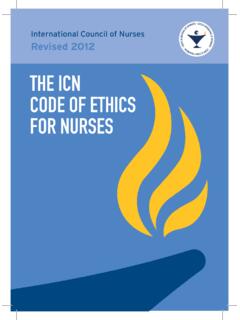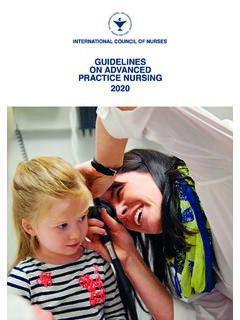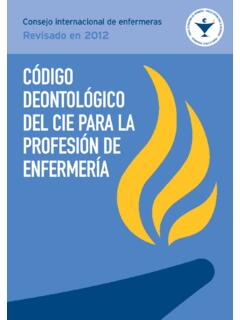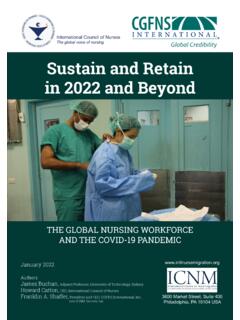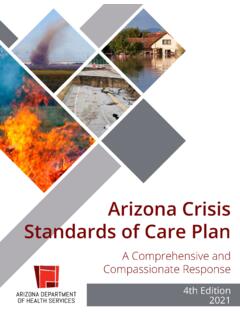Transcription of The Global Nursing shortage and Nurse Retention
1 INTERNATIONAL COUNCIL OF NURSES POLICY BRIEF 90% of NNAs are somewhat or extremely concerned that heavy workloads, and insufficient resourcing, burnout and stress related to the pandemic response are the drivers resulting in increased numbers of nurses who have left the profession, and increased reported rates of intention to leave this year and when the pandemic is over. 20% of ICN s National Nurses Associations (NNAs) reported an increased rate of nurses leaving the profession in 2020 and studies from associations around the world have consistently highlighted increased intention to leave rates. More than 70% of NNAs report that their countries are committed to increase the number of Nursing students, but highlight that when this happens there will still be a three-to-four-year gap before new graduate nurses are ready to enter the workforce.
2 During that time, they fear an exodus of experienced nurses. Due to existing Nursing shortages, the ageing of the Nursing workforce and the growing COVID-19 effect, ICN estimates up to 13 million of nurses will be needed to fill the Global Nurse shortage gap in the future. It is imperative that governments act now to mitigate the risk of increased turnover among nurses and improve Nurse MESSAGESThe Global Nursing shortageand Nurse RetentionImage credit: Nazila Ghomian, Tehran Heart Center, Iran2 The Global Nursing shortage was a well-recognised issue prior to the pandemic. In 2020, the first State of the World s Nursing (SOWN)2 report, published by the World Health Organization (WHO), revealed the Global Nursing workforce was at million and estimated there was a Global shortfall of million nurses.
3 Evidence showed that 89% of these Nurse shortages were concentrated in low- and lower-middle countries, with huge gaps in countries in the African, South-East Asia and Eastern Mediterranean WHO regions. With the ageing of the Nursing workforce, 17% of nurses globally are expected to retire within in the next ten years, and million additional nurses will need to be educated and employed just to maintain current workforce numbers, let alone address the shortages. In total, million additional nurses will be needed by Nurse shortage BEFORE COVID-19 INTERNATIONAL COUNCIL OF NURSESBACKGROUND One year on from the start of the pandemic, COVID-19 has changed the world and continues to impact our daily lives. The pandemic has highlighted gaps in healthcare systems, and the health workforce has been disproportionately exposed to the virus.
4 Throughout this past year, nurses have shown their willingness and flexibility in adapting to new ways of working. Millions of COVID-19 infections have been reported among healthcare workers globally, and tragically, the International Council of Nurses (ICN) has recorded nearly 3,000 COVID-19 related deaths among nurses in 60 countries. It is likely that the true figure is much higher, but the number of infections and deaths among healthcare workers remains impossible to assess with any accuracy because many systems and countries have not been monitoring this critical issue. In the long-term, the impacts of COVID-19, including long COVID and post-traumatic stress disorder (PTSD), could have potentially significant detrimental effects, especially on the Nursing the start of COVID-19 pandemic, ICN has highlighted the adverse impacts of the pandemic on the Nursing workforce and emphasised the importance of protection and support for nurses.
5 One year into the pandemic, reports from our National Nurses Associations (NNAs) indicate that the work of nurses in many healthcare settings continues to be emotionally and physically draining. Nurses in different countries across the world report that they are concerned about increased risks to their health posed by COVID-19 infection at work, consistently high demands of work due to the increased number of patients with critical needs, and inadequate Nurse staffing levels to respond safely and effectively to the pandemic. Evidence from various studies1 indicates that the growing COVID-19 effect, which we have described as a mass traumatisation of the Nursing workforce, could potentially exacerbate Nurse shortages globally. ICN suggests the pandemic could trigger a mass exodus from the profession in the near future and estimates the Global Nurse shortage could be widened to nearly 13 million in the aftermath of the report is intended to give an overview of the continuing challenges faced by nurses, highlight the potential medium- to long-term impacts on the Nursing workforce, and inform policy responses that need to be taken to retain and strengthen the Nursing YEAR INTO THE COVID-19 PANDEMIC The pandemic has magnified and exacerbated the Global Nursing shortage issues and obviously increased risks to the health workforce, including occupational infections, stress and burnout from months of caring for COVID-19 patients.
6 In some countries, nurses have in addition faced physical violence and psychosocial stigma. A recent survey, from the American Nurses Association4 found that at least 69% of US nurses said they agree or strongly agree that they put their patients health and safety before their own. According to the UK NHS Digital s figures, more than one-third of all sickness absences for nurses and health visitors in April 2020 were related to COUNCIL OF NURSESNURSE shortage AND Retention IN THE CONTEXT OF COVID-19 A survey conducted by ICN in December 2020 found that close to 90% of the responding NNAs said they are somewhat or extremely concerned that heavy workloads and insufficient resourcing, burnout and stress are the drivers for nurses leaving.
7 The demand on healthcare systems has increased drastically in the past year, but countries have not been able to meet the increasing needs with a corresponding increase in the Nursing workforce. Nurses are being redeployed into other care areas or specialties6, and many have been made to work longer shifts or do additional extra shifts. In response to the urgent demands, some countries have scaled up their Nursing workforce by voluntary or mandated return to practice for retired or inactive nurses. This measure can act as a temporary solution, but these nurses are unlikely to stay in the workforce in the long term. In addition, staff shortages mean that in some countries, nurses who have tested COVID-19 positive have been asked to return to work if they have no symptoms of the illness7.
8 20% of NNAs surveyed reported an increase in the number of nurses leaving the profession as a result of the pandemic. In January this year, ICN raised significant concerns about the mass trauma that is being experienced by nurses during COVID-19 pandemic, and the medium to long-term effects that trauma will have on the Nursing workforce. These issues and risks combined do not bode well for long-term Nurse Retention in an already overstretched and vulnerable workforce. The COVID-19 pandemic has the potential to increase the number of nurses reaching the point of burnout, and increase the number leaving the profession, which could have a damaging impact as early as in the second half of 20218. Country data in relation to Nurse Retention or intention to leave during the pandemic remains sparse.
9 However, studies around the world suggest the pandemic has increased nurses reported rates of intention to leave and some have already left in the past year. In the UK, a report found that National Health Service (NHS) carried nearly 40,000 Nursing vacancies and 36% of the current workforce considered leaving in 2021. Research in South Korea found that nurses intention to stay in their current job was low for nurses who had experience taking care of patients infected with COVID-19 and others who were working in COVID-19-related divisions. In the early stage of the pandemic in South Korea9, more than 10% of its nurses reported intention to Research findings in the Philippines11 show burnout and prolonged distress from the pandemic enhanced psychological anxiety and turnover intention among nurses.
10 In addition, a similar study in Pakistan12 suggests that the perceived threat of COVID-19 is an important predictor of turnover intention among nurses. In Egypt, a study revealed that over 95% of nurses had intention to leave their present job in a COVID-19 triage Hospital, while about 25% intended to leave the profession In Qatar, nurses who worked in a COVID-19 facility for more than three months have a significantly higher turnover intention than those who did not work in a COVID-19 According to reports from our NNAs, in Sweden, the Swedish Nurses Association (Vardforbundet) announced the results of a survey showing that 7% of the Nursing workforce (5,700 nurses) considered resigning due to the increased pressure and workloads in the In Denmark, a survey conducted by the Danish Nurses Organization in 2020 found that nine out of ten nurses in municipalities and regions considered leaving their jobs.



